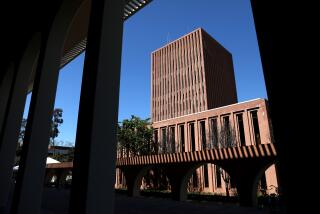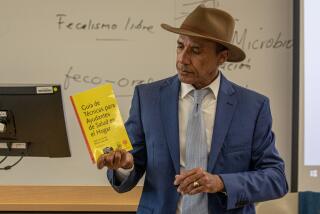Going Away to School at Home
- Share via
Students in the USC course “The Language of Cinema: An Introduction to Your Critical and Creative Voice” won’t begin the semester with a roll call. Instead, they’ll boot up their PCs.
Scores of students from around the world are expected to register for the introductory survey class, to be offered this academic year. They’ll use a CD-ROM to complete their homework assignments, listen to guest lectures through the Internet and communicate with classmates and instructors though online chats. They’ll use computers to set the lighting for a cyberspace scene and arrange still shots to follow the narrative of a script. When they’re done, they’ll know if they’re well-suited for a career in the film industry without ever having set foot on the campus of the famed film school.
The class, produced with the help of a Los Angeles start-up called Interactive Multimedia Learning Technologies, is bringing the low-tech correspondence course of old into the digital age. For roughly the same price as a regular class, schools are using PCs and computer networks to make what they call “distance learning” feasible for a broader range of classes--and useful for people in a broader range of careers.
“Distance education is becoming red-hot,” said Andy DiPaolo, director of the Stanford Center for Professional Development. “Two-thirds of the people who will be working in the year 2000 are already in the work force, and we’ve got to find ways to make sure these people are constantly educated and trained.”
Two years ago, Stanford University’s distance learning program began to deliver graduate engineering classes via the Internet to students as far away as Spain. Lectures are converted to a digitized video file and housed on computer servers that can be accessed through the World Wide Web, along with class notes, handouts and answers to frequently asked questions. Students in pursuit of a master’s degree--who must meet the university’s normal admissions requirements--rely on e-mail to communicate with professors, teaching assistants and classmates.
Across the San Francisco Bay in Berkeley, the University of California’s Extension program offers 25 courses via America Online, and 175 more courses will be added in the next two years. The program, available to anyone who wants to sign up, will expand soon onto the Web, said Mary Metz, dean of UC Berkeley Extension.
Instructors leave lecture notes and course assignments online for students to access at their convenience. Each course has an online library with direct links to related material on the Web. Lecutre by guests take place in real-time chat rooms, and students can leave e-mail for their classmates and professors.
Metz said the classes have been well received by students, even though one-third of those taking classes via AOL consider themselves “absolute beginners” when it comes to computer networks.
“A university is not bricks and mortar but professors communicating with students,” one online Berkeley Extension student said. “This forum is much better suited to meeting the needs of students where they are. I hope the future will bring a much greater range of course offerings so that the potential of this idea can be realized.”
Karen Kaplan covers technology and careers. She can be reached via e-mail at Karen.Kaplan@latimes.com.







